FAO-56 Dual Model Combined with Multi-Sensor Remote Sensing for Regional Evapotranspiration Estimations
Abstract
:1. Introduction
2. Database and Processing
2.1. Studied Site
2.2. Satellite Products
2.2.1. ERS/WSC Moisture Products
2.2.2. SPOT-VGT NDVI Products
2.3. Ground Measurements
2.3.1. Precipitation Data
2.3.2. Meteorological Data
2.4. Land Use Mapping
3. Proposed Approach for the Retrieval of Evapotranspiration
3.1. Description of the Basic FAO-56 Model
3.2. Application with a Dual Vegetation Cover
- Dr: root zone depletion (mm). The equation number 86 of the FAO No. 56 guidelines [7] is used to calculate this parameter.
- TAW: Total available soil water in the root zone (mm), estimated using the equation number 82 of the FAO No. 56 guidelines [7].
- p: fraction of TAW that a crop can extract from the root zone without suffering water stress. This parameter is derived for each class from table 22 of the FAO No. 56 guidelines [7].
3.2.1. Computing the Values of Kcb and fc
3.2.2. Computation of the Parameter Ke
3.3. Description of the ISBA Model Used to Evaluate the FAO Dual Approach
4. ISBA-A-gs Model Inter-Comparison with the FAO-56 Approach
4.1. Analysis of the ISBA-A-gs Soil Moisture Output
4.2. Inter-Comparison between ISBA-A-gs and FAO-56 Approaches
5. Conclusions
Acknowledgments
Conflicts of Interest
- Author ContributionsRim Amri and Mehrez Zribi proposed modifications and application of FAO-56 model and discussions of results. Gilles Boulet helps on analysis and interpretation of the use of FAO-56 model. Zohra Lili-Chabaane participates to ground measurements and analysis of correlation between results and the site climate. Camille Szczypta and Jean-Christophe Calvet proposed simulations of ISBA-A-gs model and participate to interpretation of comparison between FAO-56 and ISBA-Ags.
References
- Amri, R.; Zribi, M.; Lili-Chabaane, Z.; Duchemin, B.; Gruhier, C.; Chehbouni, A. Analysis of vegetation behavior in a north African semi-arid region, using SPOT-Vegetation NDVI data. Remote Sens 2011, 3, 2568–2590. [Google Scholar]
- Mueller, B.; Hirschi, M.; Jimenez, C.; Ciais, P.; Dirmeyer, P.A.; Dolman, A.J.; Fisher, J.B.; Jung, M.; Ludwig, F.; Maignan, F.; et al. Benchmark products for land evapotranspiration: LandFlux-EVAL multi-data set synthesis. Hydrol. Earth Syst. Sci 2013, 17, 3707–3720. [Google Scholar]
- Braud, I.; Dantas Antonio, A.C.; Vauclin, M.; Thony, J.L.; Ruelle, P. A. Simple Soil Plant Atmosphere Transfer Model (SisPAT): Development and field verification. J. Hydrol 1995, 166, 213–250. [Google Scholar]
- Mahfouf, J.-F.; Manzi, O.; Noilhan, J.; Giordani, H.; Déqué, M. The land surface scheme ISBA within the Météo-France climate model ARPEGE. Part I: Implementation and preliminary results. J. Clim 1995, 8, 2039–2057. [Google Scholar]
- Calvet, J.C.; Noilhan, J.; Roujean, J.L.; Bessemoulin, P.; Cabelguenne, M.; Alioso, A.; Wigneron, J.P. An interactive vegetation SVAT model tested against data from six contrasting sites. Agric. For. Meteorol 1998, 92, 92–95. [Google Scholar]
- Saux-Picart, S.; Ottlé, C.; Perrier, A.; Decharme, B.; Coudert, B.; Zribi, M.; Boulain, N.; Cappelaere, B.; Ramier, D. SEtHyS_Savannah: A multiple source land surface model applied to sahelian landscapes. Agric. For. Meteorol 2009, 149, 1421–143. [Google Scholar]
- Allen, R.G.; Pereira, L.S.; Raes, D.; Smith, M. Chapter 5. In Crop Evapotranspiration-Guidelines for Computing Crop Water Requirements, Irrigation and Drain; Paper No. 56; Food and Agriculture Organization: Rome, Italy, 1998; p. 300. [Google Scholar]
- Allen, R.G. Using the FAO-56 dual crop coefficient method over an irrigated region as part of an evapotranspiration intercomparison study. J. Hydrol 2000, 229, 27–41. [Google Scholar]
- Er-Raki, S.; Chehbouni, G.; Guemouria, N.; Duchemin, B.; Ezzahar, J.; Hadria, R. Combining FAO-56 model and ground-based remote sensing to estimate water consumptions of wheat crops in a semi-arid region. Agric. Water Manag 2007, 87, 41–54. [Google Scholar]
- Er-Raki, S.; Chehbouni, A.; Boulet, G.; Williams, D.G. Using the dual approach of FAO-56 for partitioning ET into soil and plant components for olive orchards in a semi-arid region. Agric. Water Manag 2010, 97, 1769–1778. [Google Scholar] [Green Version]
- Belaqziz, S.; Khabba, S.; Er-Raki, S.; Jarlan, L.; le Page, M.; Kharrou, M.H.; El Adnani, M.; Chehbouni, A. A new irrigation priority index based on remote sensing data for assessing the networks irrigation scheduling. Agric. Water Manag 2013, 119, 1–9. [Google Scholar]
- Campos, I.; Villodre, J.; Carrara, A.; Calera, A. Remote sensing-based soil water balance to estimate Mediterranean holm oak savanna (dehesa) evapotranspiration under water stress conditions. J. Hydrol 2013, 494, 1–9. [Google Scholar]
- Conrad, M.; Rahmann, M.; Machwitz, M.; Stulina, G.; Paeth, H.; Dech, S. Satellite based calculation of spatially distributed crop water requirements for cotton and wheat cultivation in Fergana Valley, Uzbekistan. Glob. Planet. Chang 2013, 110, 88–98. [Google Scholar]
- Mateos, L.; González-Dugo, M.P.; Testi, L.; Villalobos, F.J. Monitoring evapotranspiration of irrigated crops using crop coefficients derived from time series of satellite images. I. Method validation. Agric. Water Manag 2013, 125, 81–91. [Google Scholar]
- González-Piqueras, J. Crop Evapotranspiration by Means of Remote Sensing Determination of the Crop Coefficient. Regional Scale Application: 08-29 Mancha Oriental Aquifer; Universitat de València: Valencia, Spain, 2006. [Google Scholar]
- Purevdorj, T.; Tateishi, R.; Ishiyama, T.; Honda, Y. Relationships between percent vegetation cover and vegetation indices. Int. J. Remote Sens 1998, 19, 3519–3535. [Google Scholar]
- Sellers, P.J. Canopy reflectance, photosynthesis and transpiration. Int. J. Remote Sens 1985, 6, 1335–1372. [Google Scholar]
- Deblonde, G.; Cihlar, J. A multiyear analysis of the relationship between surface environmental variables and NDVI over the Canadian landmass. Remote Sens. Rev 1993, 7, 151–177. [Google Scholar]
- Delbart, N.; Kergoat, L.; Toan, T.L.; Lhermitte, J.; Picard, G. Determination of phenological dates in boreal regions using normalized difference water index. Remote Sens. Environ 2005, 97, 26–38. [Google Scholar]
- Myneni, R.B.; Los, S.O.; Asrar, G. Potential gross primary productivity of terrestrial vegetation from 1982 to 1990. Geophyis. Res. Lett 1995, 22, 2617–2620. [Google Scholar]
- Propastin, P.; Kappas, M. Modeling net ecosystem exchange for grassland in Central Kazakhstan by combining remote sensing and field data. Remote Sens 2009, 1, 159–183. [Google Scholar]
- Laurila, H.; Karjalainen, M.; Kleemola, J.; Hyyppä, J. Cereal yield modeling in Finland using optical and radar remote sensing. Remote Sens 2010, 2, 2185–2239. [Google Scholar]
- Fraser, R.S.; Kaufman, Y.J. The relative importance of aerosol scattering and absorption in remote sensing. IEEE Trans. Geosci. Remote Sens 1985, 23, 625–633. [Google Scholar]
- Holben, B.N.; Kaufaman, Y.J.; Kendall, J.D. NOAA-11 AVHRR visible and near-IR inflight calibration. Int. J. Remote Sens 1990, 11, 1511–1519. [Google Scholar]
- Simonneaux, V.; Duchemin, B.; Helson, D.; Er-Raki, S.; Olioso, A.; Chehbouni, A.G. The use of high resolution image time series for crop classification and evapotranspiration estimate over an irrigated area in central Morocco. Int. J. Remote Sens 2008, 29, 95–116. [Google Scholar]
- Jackson, T.J.; Schmugge, J.; Engman, E.T. Remote sensing applications to hydrology: Soil moisture. Hydrol. Sci. J 1996, 41, 517–530. [Google Scholar]
- Ulaby, F.T.; Dubois, P.C.; van Zyl, J. Radar mapping of surface soil moisture. J. Hydrol 1996, 184, 57–84. [Google Scholar]
- Paris Anguela, T.; Zribi, M.; Baghdadi, N.; Loumagne, C. Analysis of local variation of soil surface parameters with TerraSAR-X radar data over bare agricultural fields. IEEE Trans. Geosci. Remote Sens 2010, 48, 874–881. [Google Scholar]
- Calvet, J.C.; Wigneron, J.P.; Walker, J.; Karbou, F.; Chanzy, A.; Albergel, C. Sensitivity of passive microwave observations to soil moisture and vegetation water content: L-Band to W-Band. IEEE Trans. Geosci. Remote Sens 2011, 49, 1190–1199. [Google Scholar]
- Das, N.N.; Entekhabi, D.; Njoku, E.G. An algorithm for merging SMAP radiometer and radar data for high-resolution soil-moisture retrieval. IEEE Trans. Geosci. Remote Sens 2011, 49, 1504–1512. [Google Scholar]
- Kolassa, J.; Aires, F.; Polcher, J.; Prigent, C.; Jimenez, C.; Pereira, J.M. Soil moisture retrieval from multi-instrument observations: Information content analysis and retrieval methodology. J. Geophys. Res.: Atmos 2013, 118, 4847–4859. [Google Scholar]
- Wagner, W.; Noll, J.; Borgeaud, M.; Rott, H. Monitoring soil moisture over the Canadian Prairies with the ERS scatterometer. IEEE Trans. Geosci. Remote Sens 1999, 37, 206–216. [Google Scholar]
- Zribi, M.; Le Hegarat-Mascle, S.; Ottlé, C.; Kammoun, B.; Guerin, C. Surface soil moisture estimation from the synergistic use of the (multi-incidence and multi-resolution) active microwave ERS Wind Scatterometer and SAR data. Remote Sens. Environ 2003, 86, 30–41. [Google Scholar]
- Zribi, M.; André, C.; Decharme, B. A method for soil moisture estimation in Western Africa based on the ERS scatterometer. IEEE Trans. Geosci. Remote Sens 2008, 46, 438–448. [Google Scholar]
- Ceballos, A.; Scipal, K.; Wagner, W.; Martinez-Fernandez, J. Validation of ERS scatterometer-derived soil moisture data in the central part of the Duero Basin, Spain. Hydrol. Process 2005, 19, 1549–1566. [Google Scholar]
- Pellarin, T.; Calvet, J.C.; Wagner, W. Evaluation of ERS scatterometer soil moisture products over a half-degree region in southwestern France. Geophys. Res. Lett 2006, 33. [Google Scholar] [CrossRef] [Green Version]
- Paris Anguela, T.; Zribi, M.; Hasenauer, S.; Habets, F.; Loumagne, C. Analysis of surface and root-zone soil moisture dynamics with ERS scatterometer and the hydrometeorological model SAFRAN-ISBA-MODCOU at Grand Morin watershed (France). Hydrol. Earth Syst. Sci 2008, 12, 1415–1424. [Google Scholar] [Green Version]
- Zribi, M.; Chahbi, A.; Shabou, M.; Lili-Chabaane, Z.; Duchemin, B.; Baghdadi, N.; Amri, R.; Chehbouni, A. Soil surface moisture estimation over a semi-arid region using ENVISAT ASAR radar data for soil evaporation evaluation. Hydrol. Earth Syst. Sci 2011, 15, 345–358. [Google Scholar] [Green Version]
- Naeimi, V.; Bartalis, Z.; Wagner, W. ASCAT soil moisture: An assessment of the data quality and consistency with the ERS scatterometer heritage. J. Hydrometeorol 2008. [Google Scholar] [CrossRef]
- Albergel, C.; Dorigo, W.; Balsamo, G.; Muñoz-Sabater, J.; de Rosnay, P.; Isaksen, L.; Brocca, L.; de Jeu, R.; Wagner, W. Monitoring multi-decadal satellite earth observation of soil moisture products through land surface reanalyses. Remote Sens. Environ 2013, 138, 77–89. [Google Scholar]
- Wagner, W.; Scipal, K. Large scale soil moisture mapping in western Africa using the ERS scatterometer. IEEE Trans. Geosci. Remote Sens 2000, 38, 1777–1782. [Google Scholar]
- Su, C.; Ryu, D.; Young, R.; Western, A.; Wagner, W. Inter-comparison of microwave satellite soil moisture retrievals over the Murrumbidgee Basin, southeast Australia. Remote Sens. Environ 2013, 134, 1–11. [Google Scholar]
- Amri, R.; Zribi, M.; Lili-Chabaane, Z.; Wagner, W.; Hauesner, S. Analysis of ASCAT-C band scatterometer estimations derived over a semi-arid region. IEEE Trans. Geosci. Remote Sens 2012, 50, 2630–2638. [Google Scholar]
- Loew, A.; Stacke, T.; Dorigo, W.; de Jeu, R.; Hagemann, S. Potential and limitations of multidecadal satellite soil moisture observations for selected climate model evaluation studies. Hydrol. Earth Syst. Sci 2013, 17, 3523–3542. [Google Scholar]
- Holben, B.N. Characteristics of maximum-value composite images from temporal AVHRR data. Int. J. Remote Sens 1986, 7, 1417–1434. [Google Scholar]
- Rahman, H.; Dedieu, G. SMAC: A simplified method for the atmospheric correction of satellite measurements in the solar spectrum. Int. J. Remote Sens 1994, 15, 123–143. [Google Scholar]
- Maisongrande, P.; Duchemin, B.; Dedieu, G. VEGETATION/SPOT: An operational mission for the Earth monitoring; Presentation of new standard products. Int. J. Remote Sens 2004, 25, 9–14. [Google Scholar]
- Teegavarapu, R.; Chandramouli, V. Improved weighting methods, deterministic and stochastic data-driven models for estimation of missing precipitation records. J. Hydrol 2005, 312, 191–206. [Google Scholar]
- SPOT-VEGETATION Images. Available online: http://free.vgt.vito.be (accessed on 27 January 2014).
- Shepard, D. A Two Dimensional Interpolation Function for Regularly Spaced Data. Proceedings of the National Conference of the Association for Computing Machinery, Princeton, NJ, USA, 30 April–2 May 1968; pp. 517–524.
- Monteith, J.L. Evaporation and Environment. In Symposia of the Society for Experimental Biology Number XIX the State and Movement of Water in Living Organisms; Cambridge University Press: Cambridge, UK, 1965; pp. 205–234. [Google Scholar]
- Olseth, J.A.; Skartveit, A. Solar irradiance, sunshine duration and daylight illuminance derived from METEOSAT data at some European site. Theor. Appl. Climatol 2001, 69, 239–252. [Google Scholar]
- Solar Radiation Databases for Environment. Available online: http://www.soda-is.com (accessed on 27 January 2014).
- Settle, J.J.; Drake, N.A. Linear mixing and the estimation of ground cover proportions. Int. J. Remote Sens 1993, 14, 1159–1177. [Google Scholar]
- Testi, L.; Villalobos, F.J.; Orgaz, F. Evapotranspiration of a young irrigated olive orchard in southern Spain. Agric. For. Meteorol 2004, 121, 1–18. [Google Scholar]
- Mahfouf, J.F.; Noilhan, J. Comparative study of various formulations of evaporation from bare soil using in situ data. J. Appl. Meteorol. Climatol 1991, 30, 1354–1365. [Google Scholar]
- Chanzy, A.; Bruckler, L. Significance of soil surface moisture with respect to daily bare soil evaporation. Water Resour. Res 1993, 29, 1113–1125. [Google Scholar]
- Merlin, O.; Al Bitar, A.; Rivalland, V.; Beziat, P.; Ceschia, E.; Dedieu, G. An analytical model of evaporation efficiency for unsaturated soil surfaces with an arbitrary thickness. J. Appl. Meteorol. Climatol 2011, 50, 457–471. [Google Scholar]
- Deardorff, J.W. Efficient prediction of ground surface temperature and moisture, with inclusion of a layer of vegetation. J. Geophys. Res 1978, 83, 1889–1903. [Google Scholar]
- Douville, H.; Royer, J.-F.; Mahfouf, J.-F. A new snow parameterization for the Meteo-France climate model. Part 1: Validation in stand-alone experiments. Clim. Dyn 1995, 12, 21–35. [Google Scholar]
- Boone, A.; Calvet, J.-C.; Noilhan, J. Inclusion of a third soil layer in a land surface scheme using the force restore method. J. Appl. Meteorol 1999, 38, 1611–1630. [Google Scholar]
- Beven, K.; Kirkby, M.J. A physically based variable contributing area model of basin hydrology. Hydrol. Sci. Bull 1979, 24, 43–69. [Google Scholar]
- Decharme, B.; Douville, H.; Boone, A.; Habets, F.; Noilhan, J. Impact of an exponential profile of saturated hydraulic conductivity within the ISBA LSM: Simulations over the Rhône basin. J. Hydrometeorol 2006, 7, 61–80. [Google Scholar]
- Jarvis, P.G. The interpretation of the variations in the leaf water potential and stomatal conductance found in canopies in the field. Philos. Trans. R. Soc. Lond 1976, 273, 593–610. [Google Scholar]
- Arora, V.K. Modeling vegetation as a dynamic component in soil-vegetationatmosphere transfer schemes and hydrological models. Rev. Geophys 2002, 40. [Google Scholar] [CrossRef]
- Noilhan, J.; Mahfouf, J.-F. The ISBA land surface parameterization scheme. Glob. Planet. Chang 1996, 13, 145–159. [Google Scholar]
- Calvet, J.-C. Investigating soil and atmospheric plant water stress using physiological and micrometeorological data. Agric. For. Meteorol 2000, 103, 229–247. [Google Scholar]
- Calvet, J.-C.; Rivalland, V.; Picon-Cochard, C.; Guehl, J.-M. Modelling forest transpiration and CO2 fluxes—Response to soil moisture stress. Agric. For. Meteorol 2004, 124, 143–156. [Google Scholar]
- Szczypta, C.; Calvet, J.-C.; Albergel, C.; Balsamo, G.; Boussetta, S.; Carrer, D.; Lafont, S.; Meurey, C. Verification of the new ECMWF ERA-Interim reanalysis over France. Hydrol. Earth Syst. Sci 2011, 15, 647–666. [Google Scholar] [Green Version]
- Szczypta, C.; Decharme, B.; Carrer, D.; Calvet, J.-C.; Lafont, S.; Faroux, S.; Somot, S.; Martin, E. Impact of precipitation and land biophysical variables on the simulated discharge of European and Mediterranean rivers. Hydrol. Earth Syst. Sci 2012, 16, 3351–3370. [Google Scholar]
- Benhadj, I. Observation Spatial de L’Irrigation D’Agrosystèmes Semi-Arides et Gestion Durable de la Ressource en Eau en Plaine de Marrakech. In Thèse de Doctorat; Université Paul Sabatier-Toulouse III: Toulouse, France, 2008; Volume Chapter 4, p. 296. [Google Scholar]
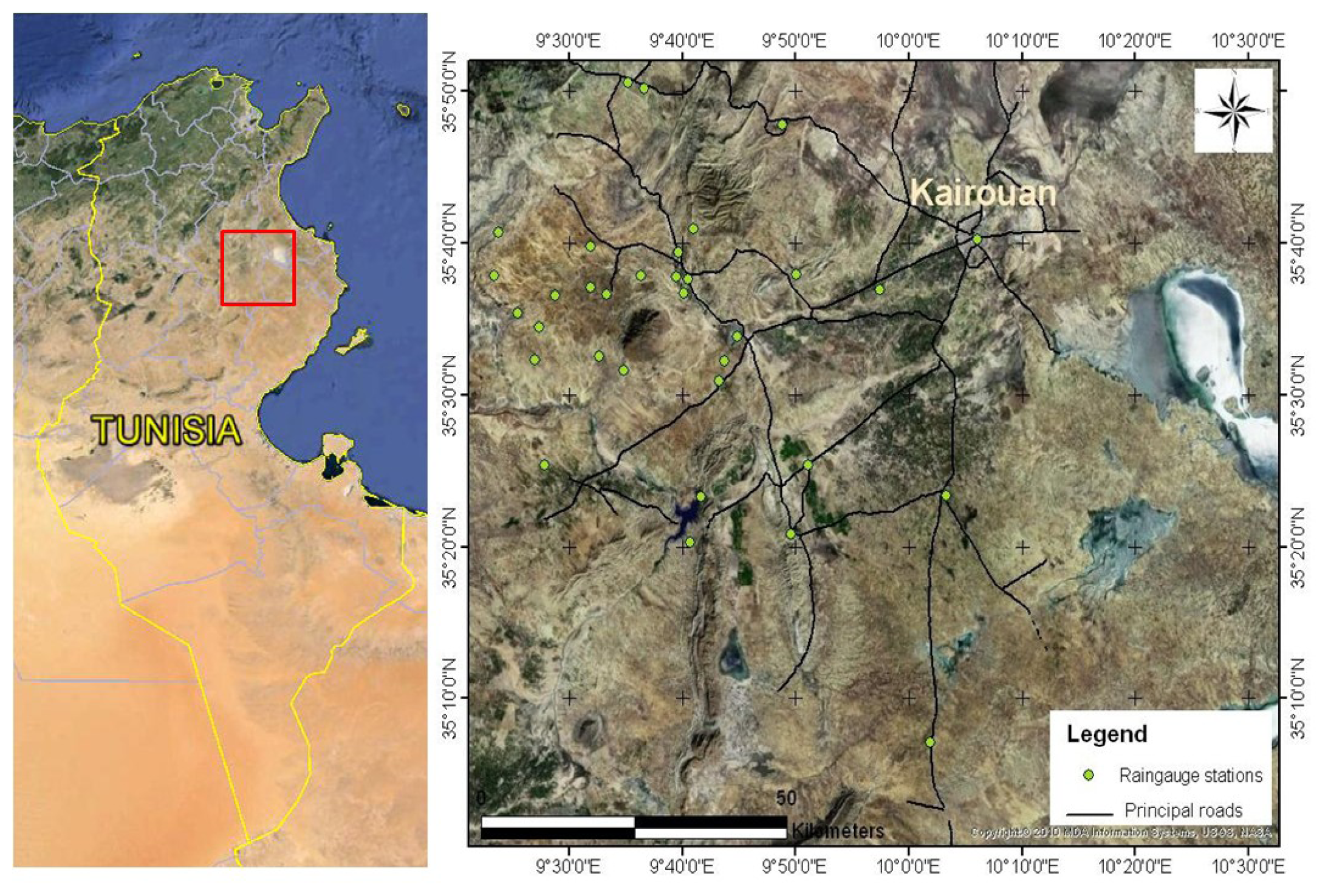
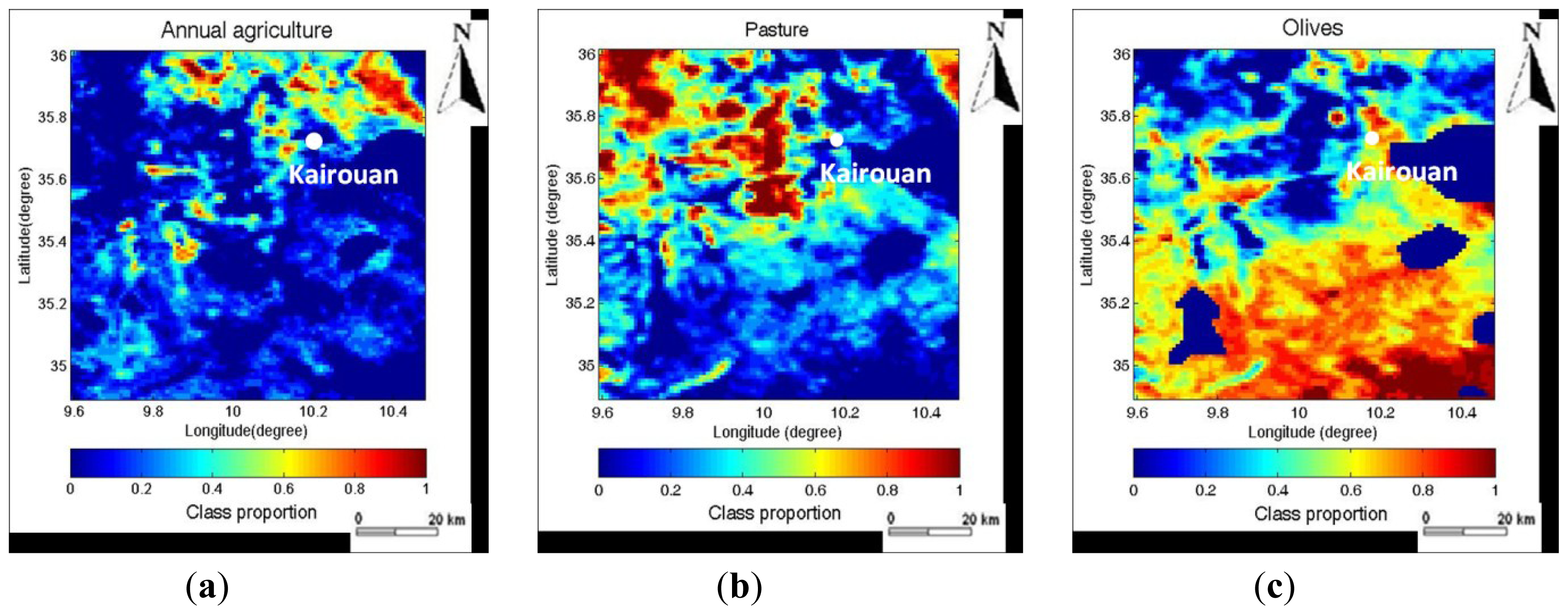

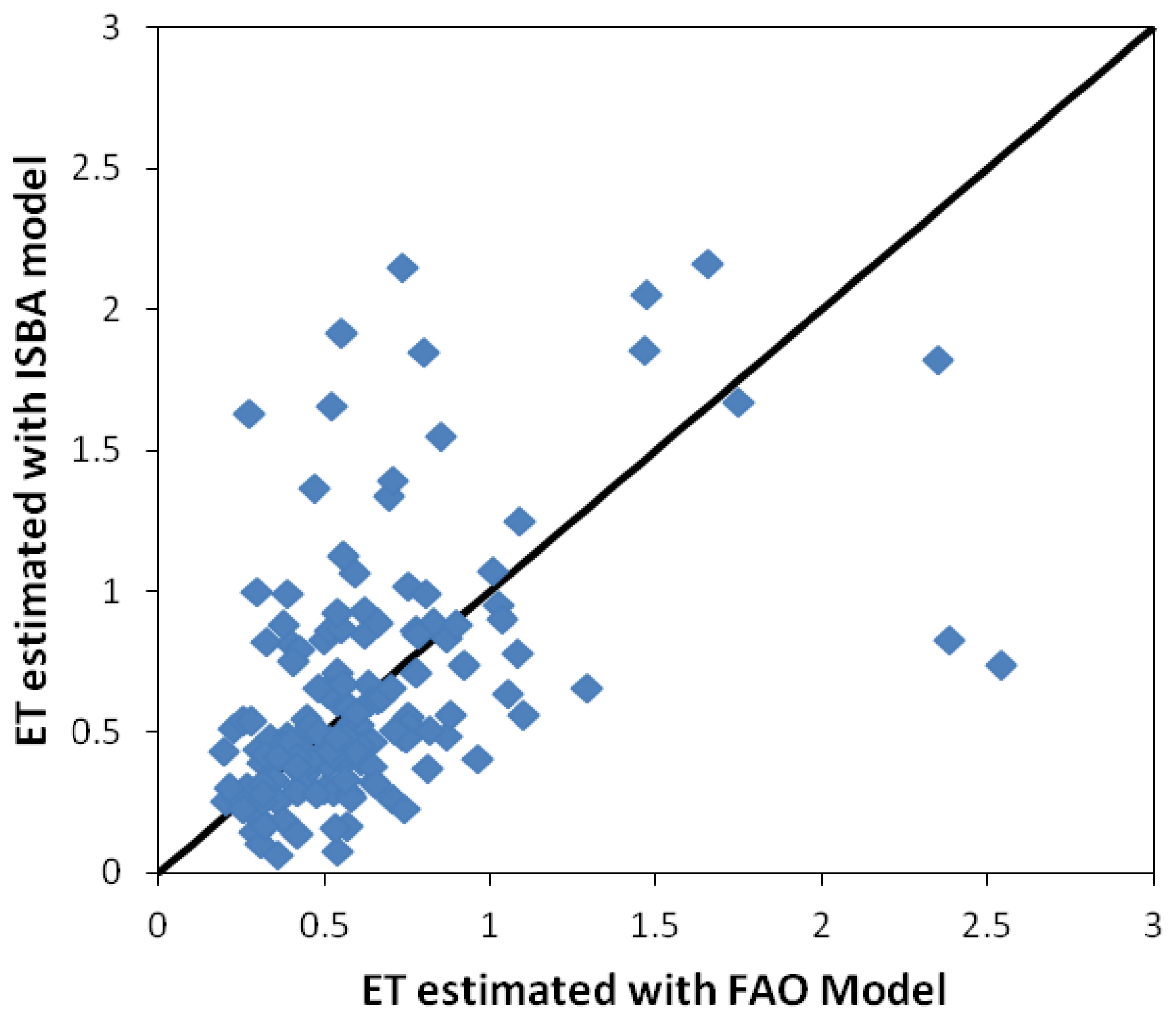
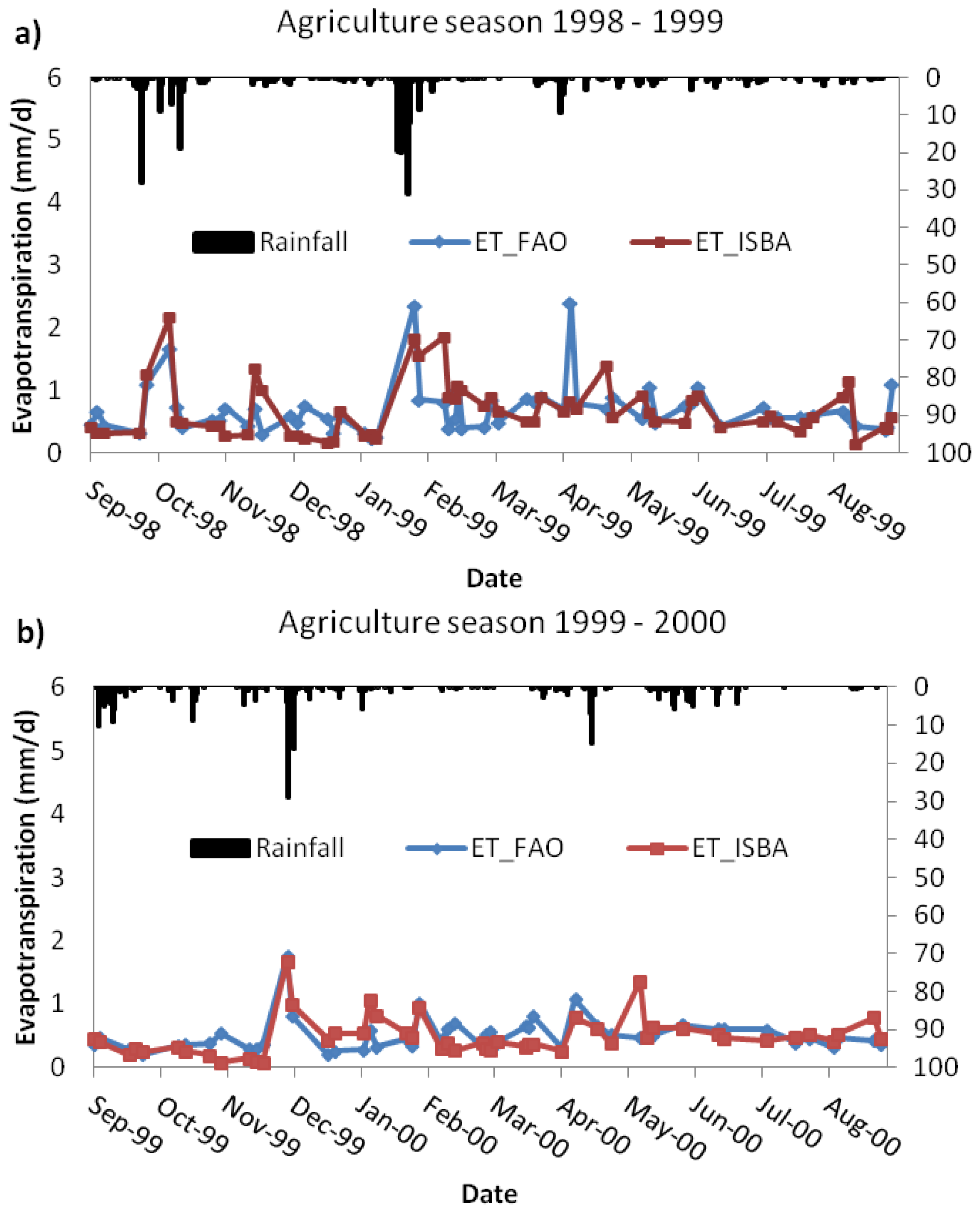
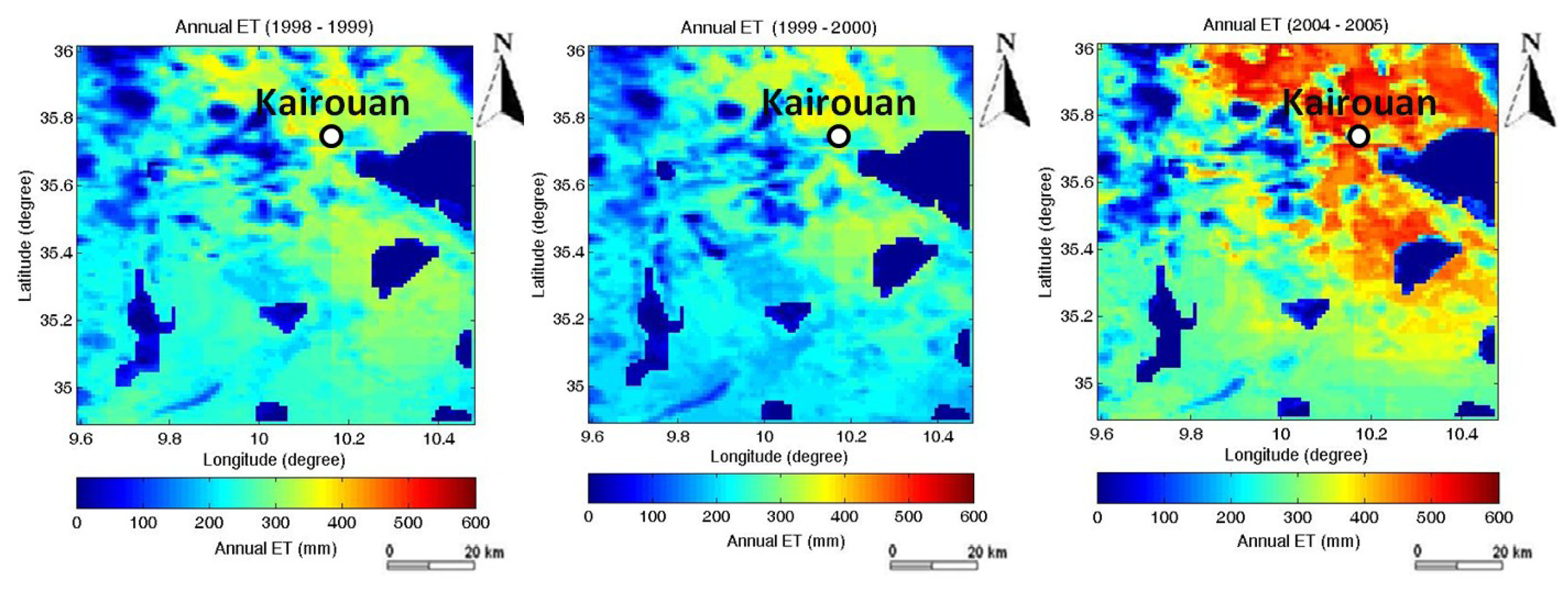
© 2014 by the authors; licensee MDPI, Basel, Switzerland This article is an open access article distributed under the terms and conditions of the Creative Commons Attribution license (http://creativecommons.org/licenses/by/3.0/).
Share and Cite
Amri, R.; Zribi, M.; Lili-Chabaane, Z.; Szczypta, C.; Calvet, J.C.; Boulet, G. FAO-56 Dual Model Combined with Multi-Sensor Remote Sensing for Regional Evapotranspiration Estimations. Remote Sens. 2014, 6, 5387-5406. https://doi.org/10.3390/rs6065387
Amri R, Zribi M, Lili-Chabaane Z, Szczypta C, Calvet JC, Boulet G. FAO-56 Dual Model Combined with Multi-Sensor Remote Sensing for Regional Evapotranspiration Estimations. Remote Sensing. 2014; 6(6):5387-5406. https://doi.org/10.3390/rs6065387
Chicago/Turabian StyleAmri, Rim, Mehrez Zribi, Zohra Lili-Chabaane, Camille Szczypta, Jean Christophe Calvet, and Gilles Boulet. 2014. "FAO-56 Dual Model Combined with Multi-Sensor Remote Sensing for Regional Evapotranspiration Estimations" Remote Sensing 6, no. 6: 5387-5406. https://doi.org/10.3390/rs6065387




